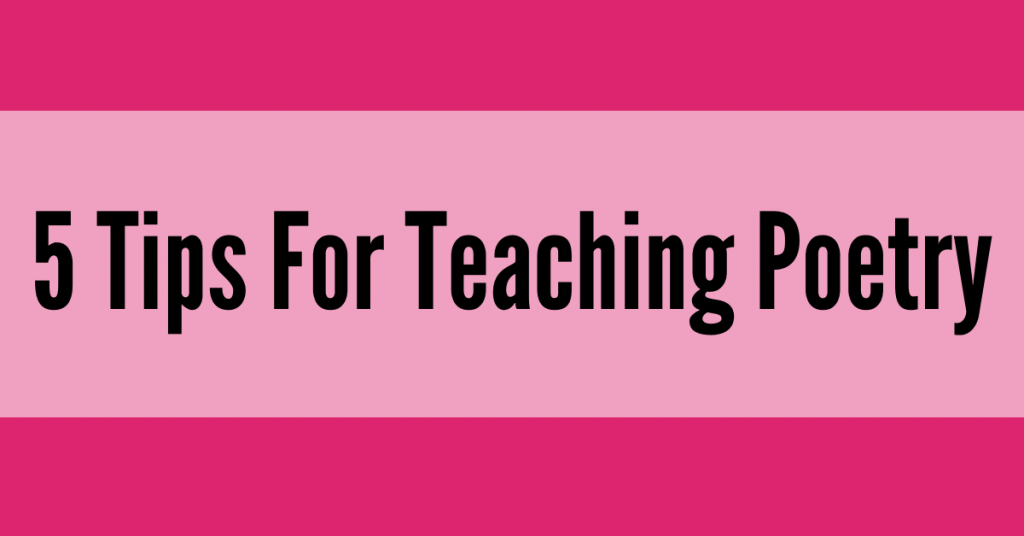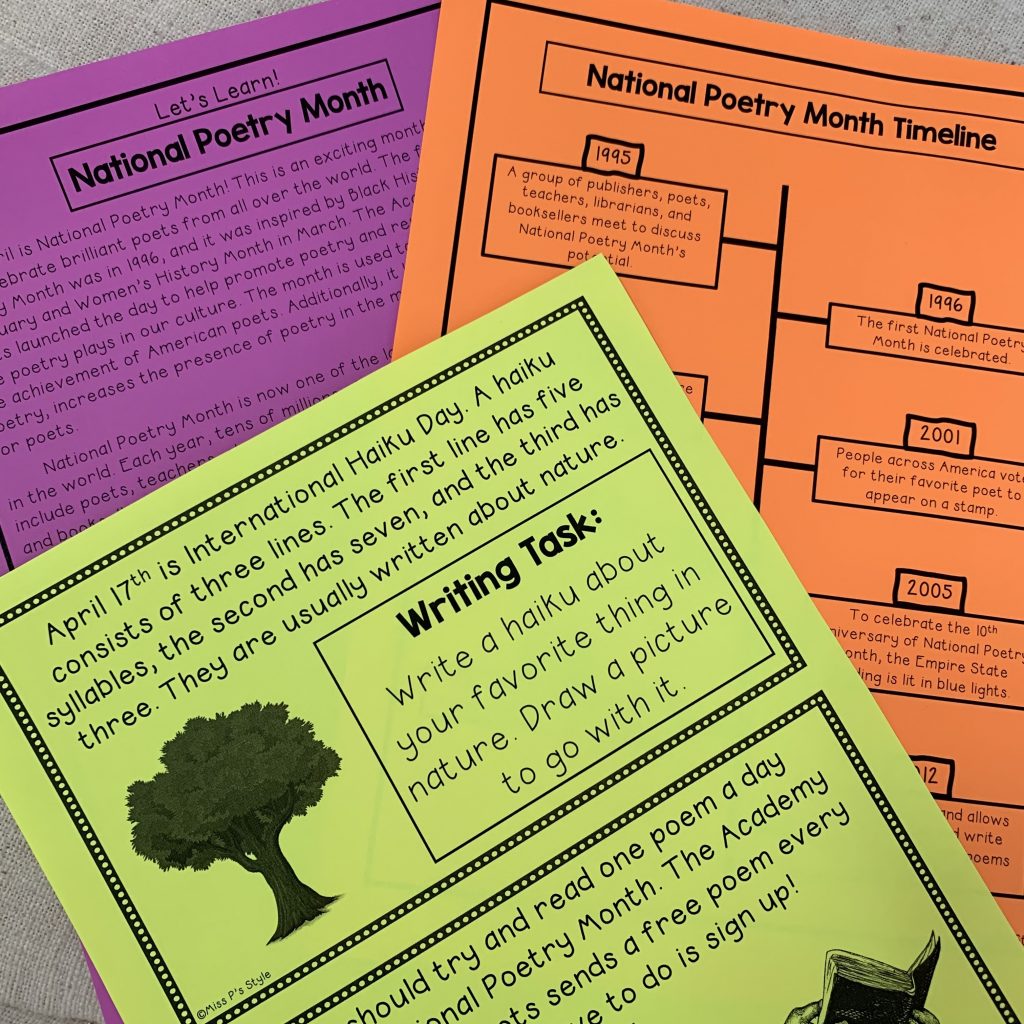
5 Tips for Teaching Poetry

April is National Poetry Month! During this month, there is a heightened focus and awareness with poetry. Exploring poetry with your class provides excellent learning opportunities because poetry is not something that is constantly taught or embedded into the curriculum. Teaching poetry no longer has to be confusing or daunting!
Reading poetry, writing poetry, performing poetry, analyzing poetry… it is not an easy task! But the benefits of being exposed to poetry are well worth it. This month was created to promote poetry and its role in our culture and society, it also highlights the many achievements of American Poets! This month also helps teachers increase the presence of poetry in schools! Teachers everywhere can spread poetry and spark a love within students for the craft… a love that would never be present without the exposure.
You may be wondering how it benefits your students…
- Teaching poetry enhances students reading and writing skills. Students learn to read and write in a different way.
- This new way of reading and writing, which comes with poetry, helps spark creativity among students. They will begin trying what poets have shown.
- Comprehension skills will improve as students are challenged to justify their thinking more than ever. Poetry has tons of figurative language and does not necessarily follow a distinct format.
- Students are taught to persevere. Poetry is challenging! But with more practice and exposure, the easier understanding poetry will become.
- Student confidence will also grow. Students are given the opportunity to challenge themselves, and they will see a reward at the end.
Are you convinced? Keep reading to find out five tips for teaching poetry in the classroom. These ideas can also be used while teaching remotely/online.
Let’s begin…
Tip 1 – Read One Poem Each Day
Did you know that during National Poetry Month, the Academy of American Poets releases one free poem each day? These poems are released to help expose students to as much poetry as possible. And all you have to do is simply sign up! Can it get any easier than that? The website is https://poets.org/poem-a-day and you and your students can get a poem a day!
What I love about this initiative is that you are now exposing your students to a wide variety of poems and you do not have to search for them on your own or pay a dime! With the poems you receive, you can
- compare them
- learn about different styles
- explore various poets, and
- practice reading them with expression and intonation
Tip 2 – Explore/Learn About Poets
This is another month of exploring biographies! In February, there was Black History Month, March was Women’s History Month and now you can keep the teaching going all through April! The focus is on ANY poet, young… old… past… present… any nationality! But how fun would it be to research African American poets or female poets?
But again, this month celebrates an awareness and celebration for all poets along with their poetry. Incorporate poets from different backgrounds and cultures. Explore what steps these poets took to become successful; explore how and where they get their inspiration. Students know the names of famous authors, but they know very few poets. One of the goals of National Poetry Month is to recognize American poets. The same website that gives you a poem a day (https://poets.org/poem-a-day) also offers a wide range of biographies of contemporary and classic poets!
If you are looking for some outstanding American poets but are unsure of where to start, try researching and sharing the lives and poetry of Maya Angelou, Mahogany L. Browne, or Robert Frost.
You can also include the history of Poetry Month into this exploration! If you would like an informative reading passage and poetry writing tasks for your students!
Tip 3 – Write Poetry
After you have exposed your students to various poems and poets, a great “next step” is to get them to write poetry. Poetry is meant to be creative and exploratory, so you should try not to give your students too many boundaries when asking them to write unless you’re focusing on a specific type like a haiku or a limerick.
Allow your students to express themselves and be sure to teach them that there is no ‘wrong’ in poetry. With this said, it can be easier to pick a specific style and teach children how to write to the specific format of the poetry form – I actually like doing it as it concretely shows the different types and the way it works BUT do give students several opportunities to write freely and expressively in their own way!
When teaching students how to write poetry, it is helpful to ensure they understand key parts they might see like: (list these then share definition)
- Alliteration: using the same sound at the beginning of words next to each other
- Personification: giving human traits to something that is not human
- Simile: comparing two things using “like” or “as”
- Metaphor: comparing two things by saying that one thing is something else
- Imagery: helping the reading form a picture in their mind
- Repetition: repeating something for effect
- Rhythm: the beat or pace of a poem
- Line Breaks: writing in shorter lines to slow down the reader
Tip 4 – Performance Poetry
One unique and fun way to explore poetry is to engage in performance poetry. This could involve performing personally written poems by students or poems by famous poets. Performance poetry provides students with another opportunity to express themselves differently – through the arts! When performing poetry, students can explore the rhythmic ways of poetry and understand why poems have been written in specific ways. They can also allow the tone and mood to lead them in their performance. It is insightful to share with them that sometimes poems are even turned into songs! Additionally, you can watch poets performing their poems – there are some fantastic clips on YouTube!
Tip 5 – Explore Different Types of Poetry
There are countless forms of poetry that you can explore during National Poetry Month and beyond. Exposing your students to as many of these as possible is essential, as it will help them understand poetry better. This intentional exposure to the different forms could spark newfound interests and joy in poetry! A child may hate rhyming poems but might love Haikus! You should provide opportunities for students to read AND write different forms of poetry. Additionally, look at poets who compose different types of poetry and look at the performance aspect of this and how performance poetry is different for different poetry types.
I love poetry and it is just fun to dive into! I feel like this intentional exposure helped my students tremendously when it came to state testing. They would always have a drama and a poem to read and answer comprehension questions about. They felt more confident reading these two genres because of the amount of exposure they received in April… right before testing time! *hint hint*
Common Forms of Poetry
If you are not sure what forms of poetry to teach to your students, I am going to share some of my common favorites:
- Sonnet – a poem with a structure of 14 lines, consisting of stanzas and couplets.
- Haiku – a form of Japanese poetry that follows a structure using syllables. They are usually written about nature.
- Narrative – a poem that tells a story.
- Limerick – a poem that has five lines and is usually humorous.
- Calligram – a form of poetry where the letters/words take the shape or layout of the poem’s meaning. Another name is shape poetry.
- Free Verse Poetry – poems with no rules or patterns and can be about any topic.
- Acrostic – a poem that spells out a word, name, or phrase with the first letter of each line.
Are you ready to celebrate National Poetry Month with your class? Follow these five tips for teaching poetry, and you will see epic results! Remember, poetry is about creativity and expression. You do not have to be an expert – you just have to provide the pieces of poetry and allow students time to explore! Try writing a poem together as a class, allow kids to work in partners, and allow students time to share and perform their poetry! Have fun!!
Share it:
- Read more about: Reading, Seasonal Activities
You might also like...

Hey, I'm Megan!
I am a literacy specialist and curriculum designer who loves sharing tips and ideas to help students thrive in literacy! It brings me joy to await those a-ha moments and to see light bulbs turn on!
I have a huge passion for reading and writing and love to co-mingle the two any chance I get! You can expect to learn new strategies and ways to keep your students engaged during your literacy block! I am so glad you’re here!






